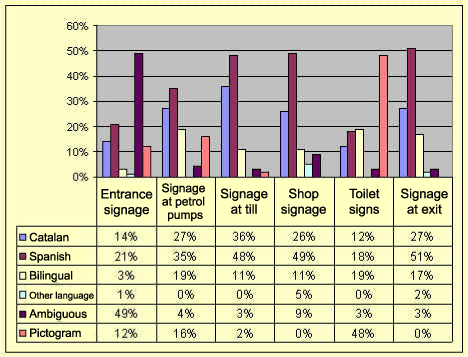 |
2. Design and execution of fieldwork
The research took the act of filling
up the tank as an action that thousands of people frequently perform. The difference
in the way this routine action is carried out by the driver and the researcher/observer is
that the latter sequentially divided the whole action into six different sections of
communication and contact in the service area with the aim of noting more closely the
language in which the range of messages are presented or transmitted.
This information
was collated by means of a questionnaire on which observations made were noted down, and
the language in which employees and/or cashiers addressed the interviewer at the moment of
greeting. We used a random sample of 533 establishments from all fuel outlets, distributed
according to province, comarca and the road network of the Principality by a system
of routes. A margin of error of 3% and a confidence interval of 95% have been allowed for.
3. Language use in petrol stations,
analysed by area of service station, territory and brand name
Spanish is the main language used in
signs and verbal interaction in almost 40% of cases. Overall use of Catalan is around 25%.
The bilingual use of Spanish/Catalan in such examples as autoservicio/autoservei
(self-service), horario/horari (opening hours), servicios/serveis (toilets)
and agua/aigua (water) makes up around 14% of signage. Resorting to ambiguity is
extensively used in logos (10% of all cases) - Campsa, Petrocat, Enaco – as well as
in product names -extradiesel, Eurosuper – as is any kind of pictogram (11%) used to
prohibit smoking or the use of naked flame, filling up with the headlights on or with the
motor running.
Figure
1: Breakdown of language use by areas of use

Source:
Language in service stations in Catalonia. Sociolinguistic contribution. 2000
A quick glance at the results of each of
the six categories reveals the scant use of Catalan in each of the service station areas
shown. Signage in Spanish is predominant in the petrol pump sections, the till, the shop
and the vending machines which are located at the exit. Companies resorted to linguistic
ambiguity in signage at the entrance, in the same proportion as the pictograms used in the
toilets category. Differences between the use of Catalan and Spanish in the
different signage categories paint a picture of two groups or forms of sociolinguistic
behaviour. On the one hand, there are between 5-10 percentage points of Spanish
predominance in the categories of entrance, till and toilets, i.e. the areas making
up the basis of any service station. On the other hand, the most dramatic differences in
favour of Spanish –up to 20 percentage points- are found in the advertisements,
posters and publicity in the shop and other sales-associated services (vending machines).
Resorting to bilingualism just exceeds exclusive use of Spanish in the toilets
category, where pictograms are predominant. |
